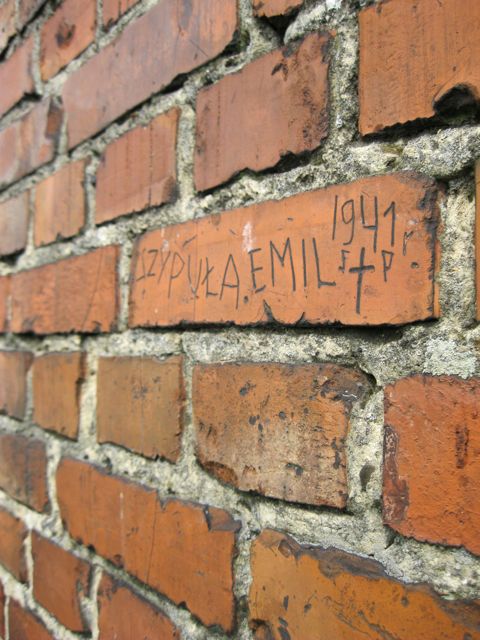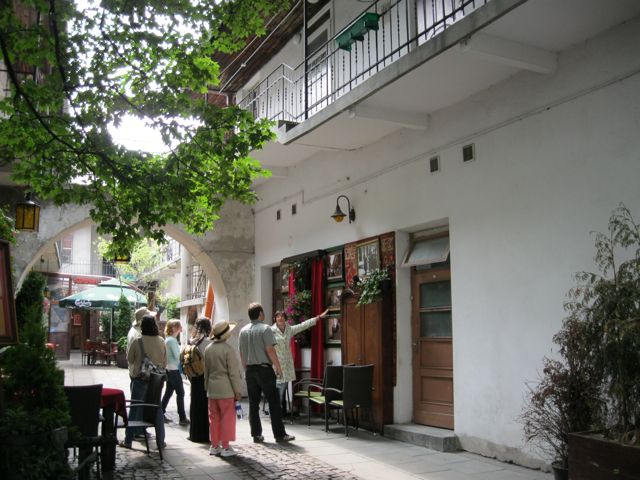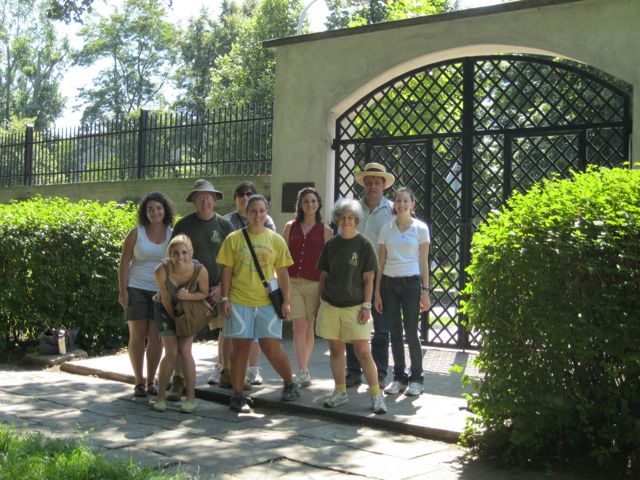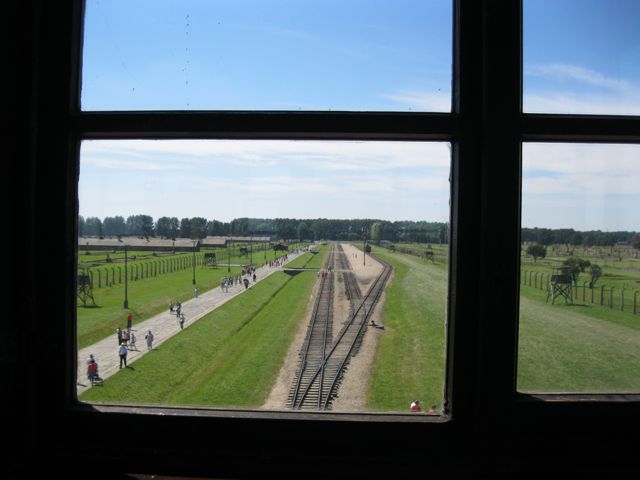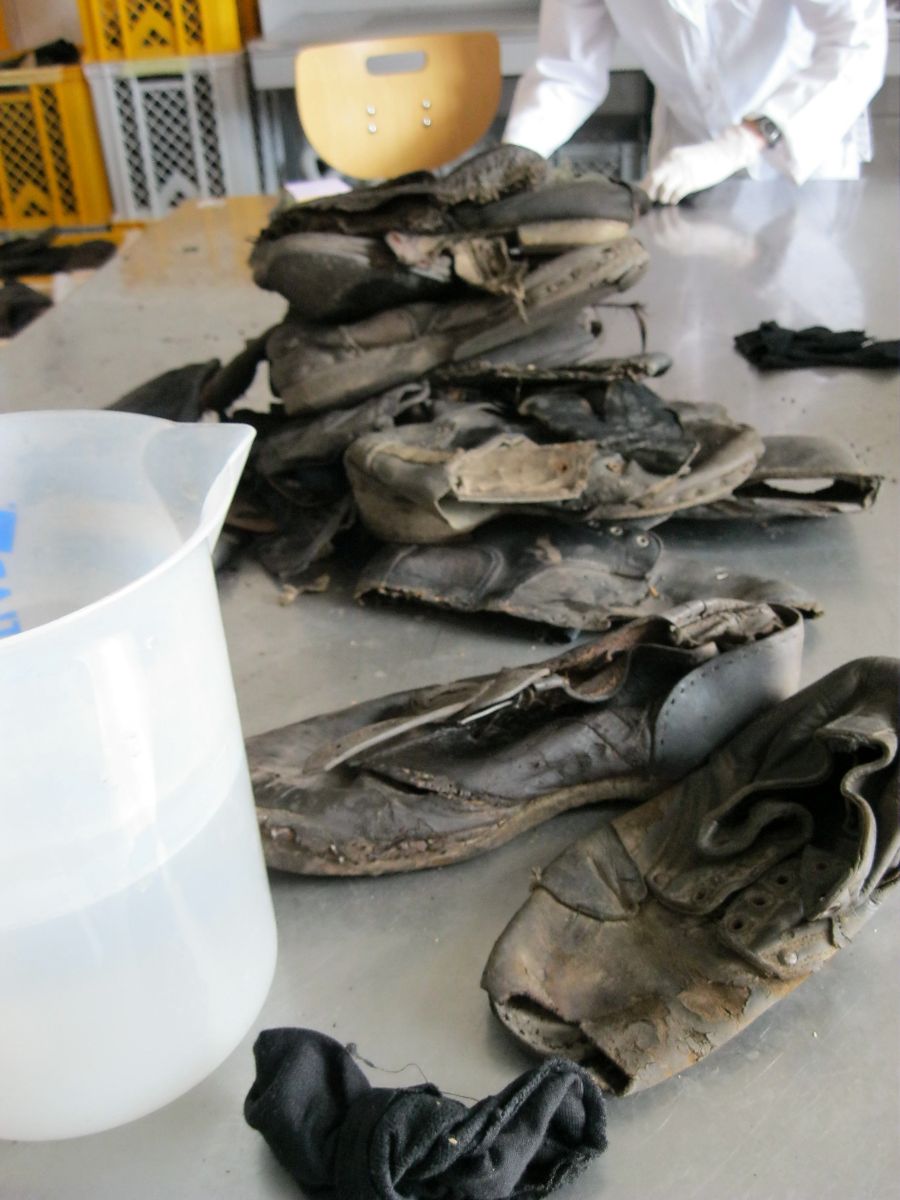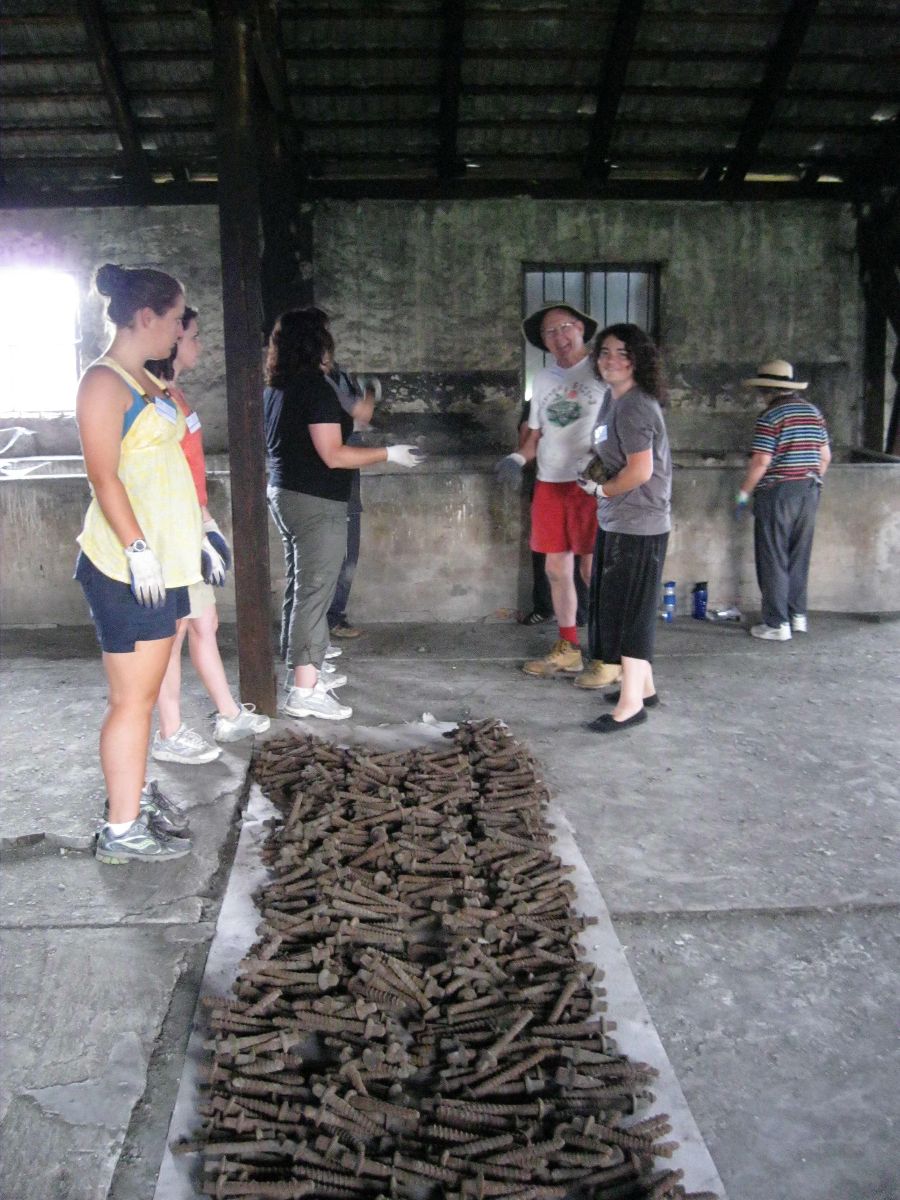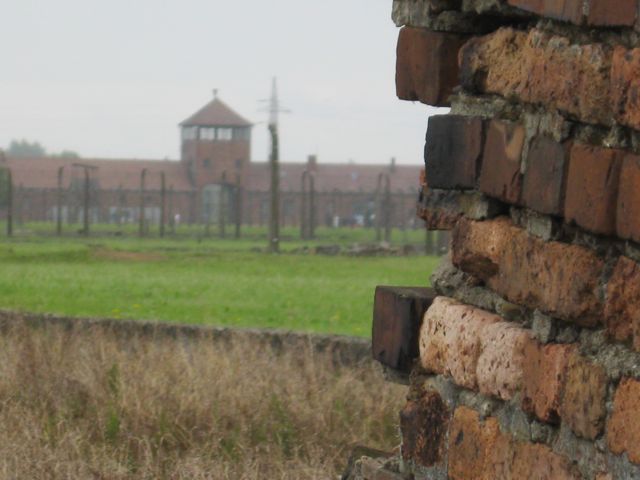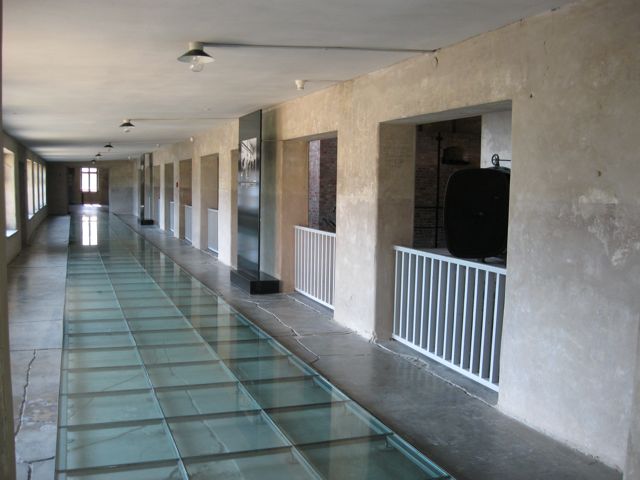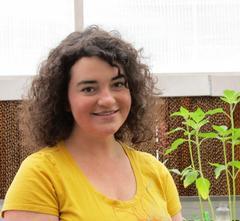Travel Fellowship Report: Milenka JiraskoAMIZADE WITNESS TO HISTORY AUSCHWITZ SERVICE LEARNING PROGRAM
Day 1: Thursday 14 July 2011 PM: Group introductions in Krakow. At a small hotel near the beautiful Main Market Square of Krakow, Poland, our group meets. We are eight American volunteers of diverse ages and backgrounds. One woman is a Holocaust professor at a university in North Carolina who also works with the Shoah Foundation. Two college-age girls have been interns at the Holocaust Museum in Washington D.C. There is a girl who has come searching for information on her grandfather and his family, and another young lady is Jewish and following her heritage. A husband and wife have come simply to volunteer and learn. And then there is me, the architecture student interested in the way we value history. Our leader, a German man with an extensive background in Holocaust studies, Political Science, and memorials, will not only be accompanying us throughout the week to offer perspective on all we see, but will also give us lectures on National Socialism and the political climate surrounding WWII. Day 2: Friday. AM: Guided tour of Kazimierz. Guided tour of Galicia Jewish Museum. PM: Travel to town of Oswiecim, Poland. Discussion at Oswiecim hotel.
Our tours of Kazimierz and the Galicia Jewish Museum both focus on the memory of Jewish culture, and how that memory is kept alive. Kazimierz is the Jewish quarter of Krakow. The movie Schindler’s List was filmed here; since then tourism has risen, along with business in ‘heritage tourism’. The Galicia Jewish Museum in Kazimierz houses a collection of photographs focused on traces of memory of Jewish culture in the Galicia region of Eastern Europe. The photographs document and explain original cultural richness in the area, cultural devastation during WWII, and ongoing revival efforts. The increase in heritage tourism has promoted historical awareness and strengthened the local economy. But there is a debate as to how this historic place should best be honored. Some feel that Kazimierz, where entire streets were emptied of their residents, should remain empty to remind us that something is missing. As stated in a caption beneath a photograph of a newly-opened traditional Jewish café in Kazimierz: “Some… feel uncomfortable with the commercialization. It fills the empty spaces where Jewish life once was and thereby conceals its absence.” (Display in Galicia Jewish Museum, 15 July 2011) After this busy morning being introduced to the importance as well as the controversies of historical tourism, we travel to the small town of Oswiecim, Poland. The name Oswiecim is, in German, "Auschwitz." Auschwitz Camp is here, and it is here that we will spend a full week. Day 3: Saturday. AM: Lecture on National Socialism. Visit Jewish Museum of Oswiecim. PM: Guided tour of Auschwitz I. Discussion. On Saturday morning we wake up in Oswiecim, Poland (which none of us can quite believe yet) and have a lecture by our leader on National Socialism. We then walk down the road to the Jewish Museum of Oswiecim. There are artifacts and rooms with photos and stories of Oswiecim Jews who survived the war and went on to live around the world. Many moved to Israel. The museum is built around an old family synagogue. It is also built alongside the house of the very last Jewish inhabitant of Oswiecim, a man who passed away in 2005. Today not a single Jew lives here. A window on the upper floors of the house is broken, and I ask about the building. A museum worker tells me that really, it is all they can do to keep it standing; one day they hope for sufficient funds to reinforce and restore the old house and make it part of the museum. As we leave the museum, a Catholic church just across the plaza is holding a service and singing. It is so crowded people are spilling out of the sanctuary, standing in the entry but still singing. We aren't sure if they sing in Polish or Latin but it is beautiful, and we stop on the doorstep to listen. In the afternoon we take a guided tour of Auschwitz I. We begin beneath the iconic Arbeit Macht Frei sign (now a copy, but we see the original later that week in the conservators' building). We then enter the camp. I am surprised at the tidiness of the brick buildings and the greenness of the grass, and I am not the only one. For some reason we thought it would be gray. We are a small enough group that we walk beside our guide without headsets, and he talks without a microphone. Most of the group tours seem to include fifteen or twenty people, all listening to their guides through headphones. It is peak season and the tours run constantly. As soon as one guide leads his group out from under the Arbeicht Macht Frei sign and into the camp a new group arrives to take their place, often in another language. The exhibits of Auschwitz- photos, prisoners' belongings, and other documents and shocking displays- are housed in the original blocks. Most of the buildings do not seem to have been altered since the closing of the camp. In one particular block I ask our guide and he says yes, the floors and walls are indeed original. No surface here has been changed. It makes me uneasy; I almost wish we didn't have direct contact with these surfaces, that we were held back from them out of respect. Day 4: Sunday. AM: Groundskeeping at Jewish cemetery in Oswiecim. PM: Guided tour of Auschwitz II-Birkenau. Discussion.
Sunday morning we walked to the Jewish cemetery of Oswiecim. During WWII the headstones were uprooted and taken away. They have since been returned, but there is no way to know which went where. So the headstones stand in simple rows, with broken ones pressed into concrete to form monuments. We pull weeds, trim hedges, cut grass, and sweep the walkways. Two weeks ago, we are told, a volunteer group of US marines passed through and did the same. We try to weed as they weeded, and to trim what has grown up since they were here. It's a surreal and inspiring thought to picture another group coming after us, and another, and another, so that the cemetery is maintained year after year by successive groups of willing travelers and local volunteers. In the afternoon we go to Auschwitz-II Birkenau, and are met by the same guide who led us yesterday through Auschwitz I. Birkenau was constructed after Auschwitz I, and intentionally made much, much larger. It is vast. We climb first into the main guard tower, the one beneath which the railroad passes, and from there we begin our tour by looking out over the whole camp. This start to the tour, being lifted up, helps us all get our bearings. It is a very specific, isolated moment in which we are able to focus and think clearly. In a way it is like a moment the day before at Auschwitz I when I stood inside a standing cell in the basement of Block 11 and was able to focus and understand a very small fragment of an overwhelming whole. The realization is something I log away for the future. Because the entire history of a site may be overwhelming, there is great value in having small, specific places where visitors isolate and absorb the experience. Either a spot like the standing cell, where dimensions, height, smell, and appearance make one small event intimately understandable. Or a place like the guard tower, where perspective can be gained.
Day 5: Monday. AM: Conserving artifacts at Auschwitz I. PM: Guided tour of art exhibit at Harmeze Monastery. Discussion. On Monday morning, we go to the conservators' building at Auschwitz. We have been told there's a possibility we may conserve artifacts like prisoners' shoes, but that street sweeping or grounds keeping is equally possible. It's with a feeling of elation, then, that we drive through the gated employee entrance and are met at the door by a conservator named Andrjez. He speaks enough English to be well understood by us, and is not shy about talking. He leads us through the different small rooms used in conservation. The dry room, for moisture-free work. The wet room, where documents are soaked and treated. The room where the original Arbeit Macht Frei sign stands. "Months of my life," he tells us, with a nod at the sign. "Months." He is the one who did much of the meticulous repair work after the sign was recovered in pieces. I love this tour. I have never been in a building designed specifically for conservation before. Each room is separated from the main hallway by glass doors, so that workspaces are visible but sealed for individual ventilation and humidity control. Along with the small staff of full-time conservators, we meet a few student interns from Poland, Germany, and elsewhere. The room where we take our places to work on shoes is small, with a sink, metal table, metal counter, and a large window looking out to the camp. A dozen or so bright yellow plastic crates are filled with shoes, old and dusty and often in pieces. We don white coats and gloves and begin the process of first washing, then disinfecting and oiling the shoes. Andrjez tells us he thinks there are about 80,000 individual shoes on display and another 80,000 kept, like these, in storage. This experience is way outside what an average visitor to Auschwitz would do, and we are fully aware and appreciative of this fact. Many of the shoes we handle are without soles, because soles were a favorite place to hide valuables, and so shoes were often torn apart to be searched after being confiscated. There are fancy women's shoes, the dressy kind that would only be taken if a woman believed - or wished to believe - that she was moving to a good life. There are men's shoes so large and heavy it is hard to believe their owners could have been taken anywhere by force, much less imprisoned. And there are a few small children's shoes. For the first couple hours none of us say much. We have, after all, just spent the weekend touring the camps. And now we are here.
Monday afternoon, we go to Harmeze monastery near Brzezinka (the Polish town alongside Birkenau camp). There is an art exhibit there, housed in the basement of the monastery. The art was done by a former prisoner of Auschwitz and dedicated to Maximilien Kolbe, the Catholic priest who took another man's place in the starvation cell of Auschwitz' Block 11. We don't know what to expect, and certainly weren't prepared for the high-quality, extensive exhibit we find, drawn on huge panels covering wall, floor, and ceiling. I am impressed, and blown away, especially since this work wasn't begun until the artist had a stroke at the age of 72. He then began to draw, massive, haunting, emotional panels of sunken eyes and hollow faces. Here and there the figure of Maximilien Kolbe is distinctly portrayed, as if to highlight some tiny kindness amid the chaos. This out-of-the-way exhibit is shown, by appointment, by the monks of the Harmeze Monastery themselves; a documentary was made of it last year.
Day 6: Tuesday. AM: Conserving artifacts at Auschwitz I. PM: Hear story of a Roma Holocaust Survivor. Video of other survivors. Discuss. On Tuesday morning we return to the conservation building at Auschwitz I, to our room with crates of shoes. It is less difficult this second day, but no less rewarding to be able to do a meaningful task, even a small one. In the afternoon, in a small conference room on the second floor of the Center for Dialogue and Prayer, we are met by a Holocaust survivor and he tells us his story. Every year there are fewer survivors, and we count ourselves fortunate. Edward (pronounced Edvard) is a Roma man. He had joined a Polish resistance movement with his older brother and was arrested trying to blow up Nazi tanks when he was only eleven years old, in 1941. He was captured, tortured for three months, and imprisoned as a political prisoner. He never revealed his Roma heritage throughout his time being tortured, deported, and imprisoned in Auschwitz; if he had, he tells us, his chances for survival would have been much, much slimmer. He survived several years in Auschwitz, until the end of the war, when he was only fifteen. After the war, he left Poland and traveled with Roma people in other countries. Eventually he met his wife, a Roma girl, and returned to Poland with her to live. He sat up straighter at this point in his story and said he would like to show us a picture of his wife, who passed away eighteen years ago. She was beautiful. After listening to his story for nearly an hour, to his accounts of brutality and hunger and the horrors of the camp, we hardly expected him to pull out a photo of his wife and talk about his family. But he did, and he smiled a little. His strength was inspiring. He has told his story over and over again, repeatedly revisiting the past for those who ask to hear it. Edward speaks to us through a translator, a young Polish woman who has just finished her doctorate studying Roma culture. She helps Edward out, then returns to talk to us on her own, and we hear about the Roma culture here in Eastern Europe since the war. Day 7: Wednesday. AM: Conserving artifacts at Birkenau. PM: Presentation from archivist in Auschwitz archives.
Wednesday morning we go with Andrjez to Birkenau. He takes us inside barracks that are not open to visitors. In one, there are railroad nails from 1945 sitting in a corner. We move them into corrosion-inhibiting plastic bags; until better storage becomes available, the bags will at least keep them from rusting further. In another barrack we move a massive pile of different railroad nails out of huge enamel tubs. These nails, Andrjez tells us, are more recent, perhaps from the sixties. They do not get any corrosion-resistant bags. It is the large enamel tubs that are historic and in need of protecting, so we set the nails on a mat on the floor so that the tubs may be cleaned. Wednesday afternoon we visit the archives in the main camp at Auschwitz I. An archivist talks to us for a while about what documents are stored here. She passes around death books and points out the meticulous record-keeping of the SS, as well as their creativity in falsification. Neither gassing nor starvation were acceptable reasons for death, so she runs her finger over page after page of death certificates with the German words for 'Tuberculosis,' 'Heart attack,' and a thousand other acceptable conditions. The archivist also tells us how families all over the world are able to request information on missing ancestors. Two of our own group had brought names to be researched, and of the several names they brought two were successfully located in the records of Auschwitz. The archivist brought copies of records to our table, for Judy and Leah to take back to the States. After leaving the archives, we walked individually through the National Exhibits. Each exhibit is designed for a specific country or ethnic group that suffered losses in WWII. For example, France and Belgium are here, among others, but so are the Roma people and the Jews. Each had either an entire Block building or one floor, and each listed the team of architects and designers responsible for the installation. From the point of view of an architecture student, the decisions each designer made and the way they were able to transform the interiors of the barracks was fascinating. Some blocked off windows completely; others darkened windows as you progressed, simultaneously moving through the story of escalating round-ups, imprisonment, and deportation; in other exhibits the windows were left open and bright to frame Auschwitz outside. One exhibit had part of the upper floor removed to create a tall lobby and staircase. Another kept the original interior walls intact, with small, claustrophobic rooms on either side of a straight, narrow hall. Every barrack, on the outside, was left completely unchanged. Even though the individuality of each interior is surprising, upon leaving the National Exhibits you are still confronted by Auschwitz, authentic and severe. Day 8: Thursday. AM: Conserving artifacts at Birkenau. PM: Guided tour of town of Oswiecim.
In the morning, we weeded the Roma Memorial at Birkenau in preparation for an upcoming remembrance ceremony. This had a special meaning for us, as two days before we heard Edward's experiences as a Roma survivor of Auschwitz. After leaving the Roma memorial, Andrjez drives us past what is left of the 'Little Red House' and 'Little White House'. These were ordinary houses appropriated by the SS, where rooms were retrofitted to carry out gassings before the crematoria and gas chambers were constructed. On the way we pass the massive unfinished brick sewage treatment towers. Andrjez tells us there were plans to harvest methane for use in making the camps more self-sufficient. "In fact," he says, "I think there were a few methane-powered vehicles running here at the camps." And it hits me, then, how recent this was, and also how methodical. In the afternoon we take a guided tour of Oswiecim. We revisit the house of the last Jewish man to live in Oswiecim, and pass a street that was once filled with Jewish shops but is now mostly empty. Day 9: Friday. AM: Lecture. Return to Krakow. PM: Visit Schindler Factory Museum. Friday morning we have a lecture and closing discussion. To be leaving the small town of Oswiecim and the camps of Auschwitz and Birkenau, after having such an intense week and meeting so many people here, feels like a very heavy farewell. In Krakow, we spend our afternoons exploring as we wish. I, along with many of the others, visit the Oskar Schindler Enamelware Factory, which recently opened as an extensive museum focused on the Nazi occupation of Krakow. Day 10: Saturday 23 July 2011. AM: Group goodbyes. The others have all flown out of Krakow by early afternoon. I booked three nights at the Center for Dialogue and Prayer in Oswiecim when we were there for our last discussion; tomorrow I will take the bus back to Oswiecim and see the camps of Auschwitz and Birkenau as an individual visitor would, and go more slowly through the exhibits. In the evenings I will return to the peace of the Center and research. I want to know more about the history of the places I've seen, though I know that will be more than the work of just a few evenings. Day 11: Sunday. AM: Return to Oswiecim without group. PM: Stay at Center for Dialogue and Prayer. The bus drops me off beside Auschwitz Museum, and I walk past the main entrance, crowded with tour buses and visitors even though it's raining, on my way to the Center for Dialogue and Prayer. The receptionists at the Center recognize me from a couple days before, and direct me to my room. This place is very popular for student groups who visit Auschwitz. There seem to be many German students in particular, especially high school students, who stay here and get both lodging and meals in the dining hall. I had not seen inside the guest rooms before, because with the Amizade group we only came here for meals and meetings. Now I unload my bag on the bed, sign up for meals in the dining hall with the other students, and get just one more perspective of the ways people visit Auschwitz. Day 12: Monday. AM: Regular tour through Auschwitz I. PM: Regular tour through Birkenau. Research in evening. On Monday, I pay a tour fee and experienced Auschwitz and Birkenau as most visitors do. With a group of about 15 others I watch a short documentary film including graphic footage taken during camp liberations, when prisoners were freed and hospitalized and the world was stunned at the conditions found here. The film is only about 20 minutes. It does not give much in-depth historical information but does effectively set the tone. We leave the small cinema grim-face and sober, clutching our headsets, and go to join our guide. The tour of Auschwitz I is no less affecting the second time around. Again the exhibits were crowded with frequent tours, but again the other visitors were, without exception, intent and sensitive. In the afternoon, we take a shuttle to Birkenau for the second half of our tour. This tour is a much faster version than the one I took with our small Amizade group. When we finish, at the memorial at the end of the tracks where railroad cars were brought into Birkenau, I am shocked at how fast our group disperses. Most seem to head straight back toward the main entrance and parking lot. I thank our guide and ask about a specific exhibit, but I am the only one who speaks to him, and he seems surprised to be approached. As I walk away, I marvel at the strength it would take to do his job year after year. He speaks for hours each day about this, a most difficult and exhausting subject, to listeners who are courteous but often relieved to escape. And I realize, as I head through the trees toward a few distant exhibits I have not yet seen, that without the weeklong program I just participated in I, too, would have been satisfied to leave quickly. Day 13: Tuesday. AM: Sketch from outside fences. Rubbings of graffiti. PM: Revisit Birkenau Sauna. Return to National Exhibits. Research in evening. On Tuesday morning, I sketch outside the fences at Birkenau. The sketches I have done have all been outside the fence, not inside as I had planned, because it does not feel right to sit inside the camp drawing, especially not inside the barracks. Later in the morning I take paper and graphite and do a few quick rubbings of prisoner graffiti on the outside of a brick barrack, where three small names are carved with faded dates from the 1940's. Then, inside another barrack, I do a contrasting rubbing of visitor graffiti. In places visitors have scratched names and years, as recent as 2010, so thickly it is impossible to see if prisoner's markings were buried beneath them. It is an unthinkable thing for visitors' to have done. The famous unrestricted access and free admission to the camps, something I greatly admire, has downsides like this. In the afternoon, I spend time lingering over a place in Birkenau that was, in retrospect, my favorite place. This is because I had a constant question in my mind, made urgent by experiences like the overcrowding of the tours in Auschwitz I and visitor vandalism coating Birkenau barrack walls, as to how a sacred place could be both respected and accessible. In Birkenau, if you walk back along the railroad tracks, back to the memorial dedicated in twenty-two languages to the victims, if you turn right past the blown-up remains of Crematorium Three and go through the trees, past the unfinished sewage treatment towers that had been planned for Birkenau's expansion, then you reach Canada. This is where belongings taken from prisoners were stored in warehouses. There was also a delousing facility called the Sauna. Now the warehouses are gone; only the Sauna remains intact. The Sauna is a long, low, brick building where both prisoners and belongings were taken, cleaned, and released. For me, the exhibit housed here in the Sauna is a serene and clear example. In defense of other displays elsewhere in Auschwitz and Birkenau, this exhibit is very new; it also had extensive outside funding. You enter the sauna on the right-hand side, the same place prisoners entered: the undressing room. You never step on the same floor the prisoners touched, but instead walk on translucent glass panels raised just a few inches and pulled away from every wall. The floor is supported on unfastened metal disks. No nails or screws pierce original surfaces. The glass walkway circles this room, past a black glass panel etched with a brief description of the previous use of this space, and then leads down a hallway and through successive chambers. Always you are held separate from every original surface, so that you feel it would be wrong to so much as run your finger along the walls. A sense of awe and respect is created through the simple act of lifting visitors off the floor, on a surface that seems fragile. The final room has a black glass floor instead of the previous translucent green. In the center are a few free-standing walls containing victims' pre-war photos- the happy photos they brought with them, and which were salvaged from suitcases here in Canada rather than destroyed. Family stories accompany the photos. There are weddings, and vacations, and children at school. The walls of photos reflect in the black glass floor. When you look down you see them, but you also see yourself. This is a spot where I, along with many others, lingered for a long time reading about the lives and names of those in the photos. When you leave you leave through the same door the prisoners left and face, once again, Birkenau.
Day 14: Wednesday 27 July 2011. AM: Depart the Auschwitz Camps and the town of Oswiecim, Poland. This is a difficult goodbye. Being here has been an academic isolation and an emotional isolation as well, and I am so glad for the person I have become, and the individuals I have met. So I have thrown away shirts to make room in my bag for books bought here at Auschwitz, all of which I've started reading because I could not choose between them. And I've signed up for an introductory German class, in preparation for a future trip to see the historic sights of Berlin. I am not happy knowing that the return to familiar places and routines will, in time, make this experience fade. All that can be done is to make sure the person I have become, and the part of me that has been altered here, does not fade. I had the humbling pleasure of getting to know individuals who, in their attitude and actions, and regardless of nationality, set a very high standard indeed. Additional Help and InformationAre you in need of assistance? Please email info@berkeleyprize.org. |
|

